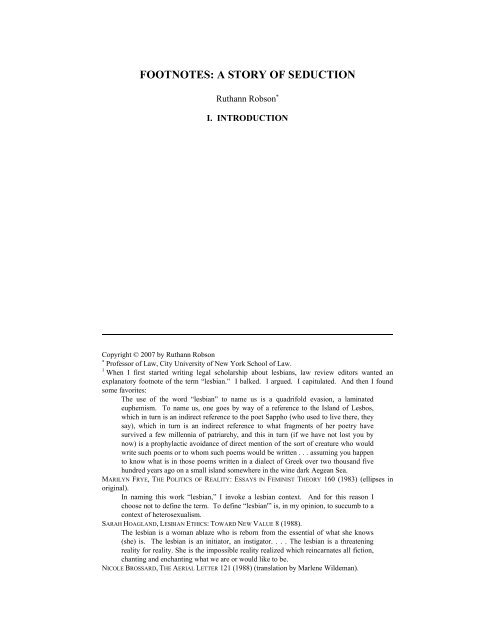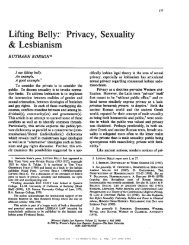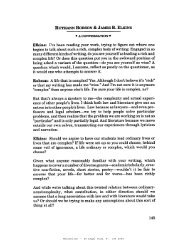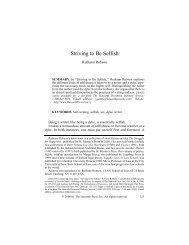FOOTNOTES: A STORY OF SEDUCTION - Ruthann Robson
FOOTNOTES: A STORY OF SEDUCTION - Ruthann Robson
FOOTNOTES: A STORY OF SEDUCTION - Ruthann Robson
You also want an ePaper? Increase the reach of your titles
YUMPU automatically turns print PDFs into web optimized ePapers that Google loves.
<strong>FOOTNOTES</strong>: A <strong>STORY</strong> <strong>OF</strong> <strong>SEDUCTION</strong><br />
<strong>Ruthann</strong> <strong>Robson</strong> <br />
I. INTRODUCTION<br />
1<br />
2<br />
Copyright © 2007 by <strong>Ruthann</strong> <strong>Robson</strong><br />
Professor of Law, City University of New York School of Law.<br />
1 When I first started writing legal scholarship about lesbians, law review editors wanted an<br />
explanatory footnote of the term “lesbian.” I balked. I argued. I capitulated. And then I found<br />
some favorites:<br />
The use of the word “lesbian” to name us is a quadrifold evasion, a laminated<br />
euphemism. To name us, one goes by way of a reference to the Island of Lesbos,<br />
which in turn is an indirect reference to the poet Sappho (who used to live there, they<br />
say), which in turn is an indirect reference to what fragments of her poetry have<br />
survived a few millennia of patriarchy, and this in turn (if we have not lost you by<br />
now) is a prophylactic avoidance of direct mention of the sort of creature who would<br />
write such poems or to whom such poems would be written . . . assuming you happen<br />
to know what is in those poems written in a dialect of Greek over two thousand five<br />
hundred years ago on a small island somewhere in the wine dark Aegean Sea.<br />
MARILYN FRYE, THE POLITICS <strong>OF</strong> REALITY: ESSAYS IN FEMINIST THEORY 160 (1983) (ellipses in<br />
original).<br />
In naming this work “lesbian,” I invoke a lesbian context. And for this reason I<br />
choose not to define the term. To define “lesbian'” is, in my opinion, to succumb to a<br />
context of heterosexualism.<br />
SARAH HOAGLAND, LESBIAN ETHICS: TOWARD NEW VALUE 8 (1988).<br />
The lesbian is a woman ablaze who is reborn from the essential of what she knows<br />
(she) is. The lesbian is an initiator, an instigator. . . . The lesbian is a threatening<br />
reality for reality. She is the impossible reality realized which reincarnates all fiction,<br />
chanting and enchanting what we are or would like to be.<br />
NICOLE BROSSARD, THE AERIAL LETTER 121 (1988) (translation by Marlene Wildeman).
1182 UMKC LAW REVIEW [Vol. 75:4<br />
II. THEORETICAL BACKGROUND<br />
3<br />
4<br />
5<br />
6<br />
2 I would like to “chant and enchant,” to “reincarnate all fiction.” I mean, who wouldn’t<br />
Discrimination would seem rather irrelevant if one is a “threatening reality for reality.” Although<br />
perhaps that’s the motivation for the discrimination There must be a theory of discrimination as<br />
retaliation.<br />
3 There are theories of everything. I have been seduced by theory, I am not ashamed to tell you.<br />
And I like to think I have seduced it in return, although that may be brash on my part.<br />
4 Here is a theory of footnotes:<br />
Like the high whine of the dentist’s drill, the low rumble of the footnote on the . . .<br />
page reassures: the tedium it inflicts, like the pain inflicted by the drill, is not random<br />
but directed, part of the cost that the benefits of modern science and technology exact.<br />
As this analogy suggests, the footnote is bound up, in modern life, with the<br />
ideology and practices of a profession.<br />
ANTHONY GRAFTON, THE FOOTNOTE: A CURIOUS HI<strong>STORY</strong> 5 (1997) (specifically discussing the<br />
theory of footnotes in the profession of history).<br />
5 My practice of footnotes started out as a physical rather than theoretical attraction. I’m in law<br />
school, in the ages before the advent of the personal computer. I have a white legal pad and a<br />
yellow legal pad, side-by-side: a couple, a dyad, a pairing. On the white legal pad, I write, in<br />
pencil, the text of the draft of my first law review article. On the yellow legal pad—as you’ve<br />
already guessed—I write, in pencil, the footnotes of the draft of my first law review article. There<br />
is something seductive in this, and not only because there is a lesbian chanting and enchanting in<br />
those penciled pages. Most people don’t notice her. But I do. See People v. Lovercamp, 118 Cal.<br />
Rptr. 110 (Cal. Ct. App. 1974).<br />
To see her. Her. See!<br />
The confusion about the “see” signal was resolved by the seventeenth edition of The Bluebook,<br />
which provided that [no signal] is used when the “[c]ited authority (i) directly states the<br />
proposition" (ii) identifies the source of a quotation, or (iii) identifies an authority referred to in the<br />
text,” while the signal “see” should be used when the cited authority “clearly supports the<br />
proposition” as when the “proposition is not directly stated by the cited authority but obviously<br />
follows from it; there is an inferential step between the authority cited and the proposition it<br />
supports.” Rule 1.2, THE BLUEBOOK: A UNIFORM SYSTEM <strong>OF</strong> CITATION 22-23 (Columbia Law<br />
Review Ass’n et al. eds, 17th ed. 2000). The sixteenth edition, published four years earlier had<br />
omitted the category of “directly states the proposition” from the [no signal] designation and had<br />
provided that “see” should be used when the cited authority “directly states or clearly supports the<br />
proposition.” Rule 1.2, THE BLUEBOOK: A UNIFORM SYSTEM <strong>OF</strong> CITATION 22 (Columbia Law<br />
Review Ass’n et al. eds, 16th ed. 1996). This was a departure from previous Bluebook<br />
formulations which provided that “see” as a signal was an indication that there was some inference<br />
that was required. E.g., Rule 1.2, The BLUEBOOK: A UNIFORM SYSTEM <strong>OF</strong> CITATION 6 (Columbia<br />
Law Review Ass’n et al. eds, 12th ed. 1976) (“See: cited authority constitutes basic source material<br />
that supports the proposition. ‘See’ is used instead of ’[no signal]’ when the proposition is not<br />
stated by the cited authority but follows from it.”).
2007] <strong>FOOTNOTES</strong>: A <strong>STORY</strong> <strong>OF</strong> <strong>SEDUCTION</strong> 1183<br />
7<br />
8<br />
9<br />
10<br />
6 See! Physical because writing, like seduction, is both mental and physical. Listen to this:<br />
Contact between the point of a pen and a sheet of paper is the locus of the realization<br />
of a physical relationship that finds its basis in a desire to transmit a message, and in<br />
the recognition of the formal conventions of writing as a means of communication.<br />
The point of a pen carries out actions which are grounded in the desire to elaborate a<br />
visual thought, and it turns itself into an instrument for an initial and theoretical<br />
understanding of something which is attempting to take shape in the mind, of<br />
something that seeks its structure in the real experience [of] a place, and in various<br />
sensations, motivations, and circumstances that necessarily have a bearing on the<br />
artist’s—the sculptor’s—“professional” activities.<br />
MAURO STACCIOLI, SCULPTURA 11 (1990).<br />
There’s that term “professional” again. Only this time, it’s not dentistry or history or even law,<br />
but sculpture.<br />
7 No. I am not a sculptor. Although I have been a “resident artist” at the Djerassi Resident Artists<br />
Program in mountains overlooking the Pacific Ocean, where I first saw the sculptures of Mauro<br />
Staccioli embedded in a California live oak grove, next to a redwood grove, next to a meadow. See<br />
http://www.djerassi.org (last visited Nov. 16, 2006). There are six sculptures, huge concreteseeming<br />
forms in stark shapes that play against the landscape. They impose upon it, like footnotes.<br />
8 Footnotes are not supposed to impose. “What footnotes should be used for, however, is citations.<br />
If the reader knows this is all they contain, the reader is not even apt to glance at them unless a<br />
specific verification need arises.” Thomas Haggard, In Defense of the Lowly Footnote, 10 S.C.<br />
LAW. 12 (Apr. 1999); cf. K.K. DeCivier, The Footnote: An Interruption, 26 COLO. LAW. 47 (May<br />
1997) (arguing that footnotes may be helpful to supplement statements in the text with extensive<br />
quotes or string cites and may a good way to respond to peripheral points by opposing counsel).<br />
But cf. J.M. Balkin, The Footnote, 83 NW. U. L. REV. 275 (1989) (“Perhaps the footnote might state<br />
the real point of the article in a highly economical way.”).<br />
9 Contra Robert A. Destro, Federalism, Human Rights, and the Realpolitik of Footnote Four, 12<br />
WIDENER L.J. 373 (2003); Felix Gilman, The Famous Footnote Four: A History of the Carolene<br />
Products Footnote 4, 6 S. TEX. L. REV. 163 (2004); Peter Linzer, The Carolene Products Footnote<br />
and the Preferred Position of Individual Rights: Louis Lusky and John Hart Ely vs. Harlan Fiske<br />
Stone, 12 CONST. COMMENT. 277 (1995); Louis Lusky, Footnote Redux: A Carolene Products<br />
Reminiscence, 82 COLUM. L. REV. 1093 (1982); Matthew Perry, Justice Stone and Footnote 4, 6<br />
GEO. MASON U. CIV. RTS. L.J. 35 (1996); L.A. Powe, Jr., Does Footnote Four Describe, 11<br />
CONST. COMMENT. 197 (1994); Elizabeth J. Wallmeyer, Filled Milk, Footnote Four & The First<br />
Amendment: An Analysis of the Preferred Position of Speech After the Carolene Products Decision,<br />
13 FORD. INTELL. PROP. MEDIA & ENT. L.J. 1019 (2003).<br />
10 This most famous footnote in American jurisprudence provides:<br />
There may be narrower scope for operation of the presumption of constitutionality<br />
when legislation appears on its face to be within a specific prohibition of the<br />
Constitution, such as those of the first ten Amendments, which are deemed equally<br />
specific when held to be embraced within the Fourteenth. [citation omitted].
1184 UMKC LAW REVIEW [Vol. 75:4<br />
11<br />
12<br />
13<br />
14<br />
It is unnecessary to consider now whether legislation which restricts those political<br />
processes which can ordinarily be expected to bring about repeal of undesirable<br />
legislation, is to be subjected to more exacting judicial scrutiny under the general<br />
prohibitions of the Fourteenth Amendment than are most other types of legislation.<br />
On restrictions upon the right to vote, see [citations omitted]; on restraints upon the<br />
dissemination of information, see [citations omitted]; on interferences with political<br />
organizations, see [citations omitted]; as to prohibition of peaceable assembly, see<br />
[citation omitted].<br />
Nor need we enquire whether similar considerations enter into the review of statutes<br />
directed at particular religious, [citation omitted] or national [citations omitted], or<br />
racial minorities [citations omitted]; whether prejudice against discrete and insular<br />
minorities may be a special condition, which tends seriously to curtail the operation of<br />
those political processes ordinarily to be relied upon to protect minorities, and which<br />
may call for a correspondingly more searching judicial inquiry. Compare [citations<br />
omitted].<br />
United States v. Carolene Prod. Co., 304 U.S. 144, 152-53 n.4 (1938).<br />
11 I am not embarrassed to admit that when I first heard about footnote four, in law school it must<br />
have been, when I was drafting my own footnotes on those yellow legal pads, a lesbian chanting<br />
and enchanting in the pencil marks, I thought it a mighty fine and perhaps even helpful footnote.<br />
Certainly there was lots of “prejudice” and I’d bet my bottom dollar that dykes were a “discrete and<br />
insular minority,” though it had recently been mentioned to me that I was not nearly discrete<br />
enough. I might add that this was the time of Anita Bryant, both of us living in the Sunshine State.<br />
No, we were not former lovers! Though I did think once or twice that she must have been “seduced<br />
and abandoned” to be so angry and involved with the “queer” issue. See ANITA BRYANT, THE<br />
ANITA BRYANT <strong>STORY</strong>: THE SURVIVAL <strong>OF</strong> OUR NATION’S FAMILIES AND THE THREAT <strong>OF</strong> MILITANT<br />
HOMOSEXUALITY (1977).<br />
12 The courts were not kind. Maybe not always as consistently mean-spirited, paranoid, and Biblequoting<br />
as Ms. Bryant (although sometimes, indeed, they were) [citations omitted]. But not kind.<br />
13 And I kind of expected better from some legal theorists.<br />
14 See e.g., Jeremy Waldron, The Core of the Case Against Judicial Review, 115 YALE L.J. 1346,<br />
1404 n.141 (2006) (“It is important also to distinguish between prejudices and views held strongly<br />
on religious or ethical grounds. We should not regard the views of pro-life advocates as prejudices<br />
simply because we do not share the religious convictions that support them. Almost all views about<br />
rights—including pro-choice views—are deeply felt and rest in the final analysis on firm and deepseated<br />
convictions of value).
2007] <strong>FOOTNOTES</strong>: A <strong>STORY</strong> <strong>OF</strong> <strong>SEDUCTION</strong> 1185<br />
III. THIS IS THE BODY <strong>OF</strong> THIS “ARTICLE”<br />
15<br />
16<br />
17<br />
18<br />
19<br />
20<br />
21<br />
22<br />
23<br />
15 So, here’s the thing: When someone is screaming at me that I am a child molester and pervert<br />
and freak and should be jailed or burn in hell, I’m not really impressed that the source of their<br />
violence is a religious conviction. I’m fifteen or sixteen or eighteen or twenty or twenty-two and<br />
already writing footnotes. I’m going into a bar, a women’s coffee house, a fucking bookstore, and<br />
they are screaming and throwing bottles and carrying signs. I’m not going to admit to you that I am<br />
scared, because I’m going to tell you I never was, not once was I ever scared, not once.<br />
16 Footnotes are your friends, I tell my students. You can be called names on the street (indulge me<br />
in my use of the passive voice, dear editors, dear readers; I have my political reasons for resorting<br />
to it), but you can fight back with footnotes.<br />
17 Each footnote I have ever written is a little shield.<br />
18 Yes, I am a pacifist. But some things are non-negotiable.<br />
19 My body.<br />
20 Her body.<br />
21 Our bodies together.<br />
22 That is the story I have to tell, to tell over and over and over and over in as many ways as<br />
possible. It is the story that seduced me. The story that I seduced out of nothing with only my<br />
passion.<br />
23 Things are different now, they say. Better, don’t you think I mean, there are lesbians on<br />
television for goodness sakes. And the law has “evolved.” I mean, you two could go to<br />
Massachusetts and marry each other! Or to South Africa, probably. And there are civil unions and<br />
civil partnerships and domestic partnerships and all sorts of things were you can bind yourselves to<br />
each other and to the state—a sort of cute little threesome, don’t you think Do you know the term<br />
“ménage à trois” In Goodridge v. Department of Pub. Health, 798 N.E.2d 941 (Mass. 2003), the<br />
controversial same-sex marriage opinion by the Massachusetts Supreme Judicial Court, the court<br />
articulated it so clearly: marriage is a relationship amongst “three partners”: “two willing spouses<br />
and an approving State.” Id. at 954. I kind of find that scary. Not that I don’t like Massachusetts.<br />
But still. I have never been seduced by a state. I’ve never been passionate about a state. Though<br />
of course, I have put many states in many footnotes over the years. And traveled in my body to<br />
many states. Including Massachusetts. I’ve a fondness for Massachusetts, actually, for that’s<br />
where my life was saved. But that’s another story, although certainly a story about the body, see<br />
<strong>Ruthann</strong> <strong>Robson</strong>, Notes from a Difficult Case, 21 CREATIVE NONFICTION 6 (2003), reprinted in IN<br />
FACT: THE BEST <strong>OF</strong> CREATIVE NONFICTION (Lee Gutkind ed., 2005).
1186 UMKC LAW REVIEW [Vol. 75:4<br />
IV. CONCLUSION<br />
24<br />
25<br />
26<br />
27<br />
24 I and my lover could now be included in this statement: Pennsylvania Judge (and later Dickinson<br />
Law School Dean) Laub once said, “Anyone who reads a footnote in a judicial opinion would<br />
answer a knock at his hotel door on his wedding night.” Gerald Lebovits, The Bottom Line on<br />
Footnotes and Endnotes, 75 N.Y. St. B. J. 64 & n.3 (Jan. 2003) (citing RUGGERO J. ALDISERT,<br />
OPINION WRITING 177 (1990) (quoting Burton S. Laub)).<br />
25 But I had wanted a revolution and thought that it might blossom on a yellow legal pad, with<br />
carefully written text, punctuated by numbers, as if it were a sculpture. Art, I thought, had<br />
potential. As did law. Dentistry I was not so sure about and never considered it as a profession.<br />
History, yes. There was history. But I have always loved the future. A future with her.<br />
26 As Nicole Brossard has written, “a lesbian who does not reinvent the world is a lesbian in the<br />
process of disappearing.” BROSSARD, supra note 1, at 136. Similarly, Monique Wittig’s famous<br />
instruction in Les Guérillerès is “Make an effort to remember. Or, failing that, invent.” MONIQUE<br />
WITTIG, LES GUÉRILLERÈS 89 (David LeVay trans., 1969).<br />
27 We must seduce our revolution.






